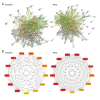Potential of Gut Microbial Metabolites in Treating Osteoporosis and Obesity: A Network Pharmacology and Bioinformatics Approach
- PMID: 38509819
- PMCID: PMC10938863
- DOI: 10.12659/MSM.942899
Potential of Gut Microbial Metabolites in Treating Osteoporosis and Obesity: A Network Pharmacology and Bioinformatics Approach
Abstract
BACKGROUND The gut microbial metabolites demonstrate significant activity against metabolic diseases including osteoporosis (OP) and obesity, but active compounds, targets, and mechanisms have not been fully identified. Hence, the current investigation explored the mechanisms of active metabolites and targets against OP and obesity by using network pharmacology approaches. MATERIAL AND METHODS The gutMGene database was used to collect gut microbial targets-associated metabolites; DisGeNET and OMIM databases were used to identify targets relevant to OP and obesity. A total of 63 and 89 overlapped targets were considered the final OP and obesity targets after creating a Venn diagram of metabolites-related targets and disease-related targets. Furthermore, the top 20% of degrees, betweenness, and closeness were used to form the sub-network of protein-protein interaction of these targets. Finally, the biotransformation-increased receptors and biological mechanisms were identified and validated using ADMET properties analysis, molecular docking, and molecular dynamic simulation. RESULTS GO, KEGG pathway analysis, and protein-protein interactions were performed to establish metabolites and target networks. According to the enrichment analysis, OP and obesity are highly linked to the lipid and atherosclerosis pathways. Moreover, ADMET analysis depicts that the major metabolites have drug-likeliness activity and no or less toxicity. Following that, the molecular docking studies showed that compound K and TP53 target have a remarkable negative affinity (-8.0 kcal/mol) among all metabolites and targets for both diseases. Finally, the conformity of compound K against the targeted protein TP53 was validated by 250ns MD simulation. CONCLUSIONS Therefore, we summarized that compound K can regulate TP53 and could be developed as a therapy option for OP and obesity.
Conflict of interest statement
Figures









References
-
- Cummings SR, Melton LJ. Epidemiology and outcomes of osteoporotic fractures. Lancet. 2002;359(9319):1761–67. - PubMed
-
- Che J, Yang J, Zhao B, Shang P. HO-1: A new potential therapeutic target to combat osteoporosis. Eur J Pharmacol. 2021;906:174219. - PubMed
-
- Zhu N, Hou J. Exploring the mechanism of action Xianlingubao Prescription in the treatment of osteoporosis by network pharmacology. Computa Biol Chem. 2020;85:107240. - PubMed
-
- Zhao F, Guo Z, Kwok L-Y, et al. Bifidobacterium lactis Probio-M8 improves bone metabolism in patients with postmenopausal osteoporosis, possibly by modulating the gut microbiota. Eur J Nutr. 2023;62(2):965–76. - PubMed
-
- Chen Z, Cai Z, Zhuang P, et al. Living probiotic biomaterials for osteoporosis therapy. Biomedical Technology. 2023;1:52–64.
MeSH terms
Substances
LinkOut - more resources
Full Text Sources
Medical
Research Materials
Miscellaneous

